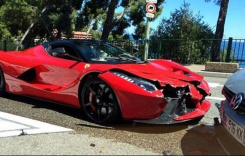The 450 motocross class heats up with the release of Kawasaki’s all-new KX450F. For 2016, engineers went back to the drawing board giving the premier class KX-F its first major overhaul in seven years.
Engine
Since its inception a decade ago, Kawasaki’s KX450F engine has developed a reputation as an absolute powerhouse. And for ’16 it looks to build that legacy with an overhauled design that’s lighter, smoother and more powerful. Engine cases are reshaped and fabricated from thinner aluminum castings. The cylinder has shifted forward (8.5mm) for improved combustion efficiency, which also allowed engineers remove weight from the engine’s bottom-end (3.3 ounces). While that may not seem like much, the weight savings is compounded when the crankshaft is spinning in the meat of its 11,450 rpm powerband. In fact, engineers were so hell bent on shaving weight, even the kickstarter was re-tooled and is now 2.6 ounces lighter.

Milder bottom-end engine power paired with rear suspension enhancements help the KX450F hook-up maximizing forward drive off turns.
Inside, a new piston (12:8.1 compression ratio unchanged) with a reshaped crown accommodates the revised contour of the intake valves (diameter also unchanged at 36mm). The valvetrain is spun by a pair of lighter camshafts (1.2 ounces) with more timing advance on the rear intake cam for stronger bottom-end power. Lastly, a new cylinder head was bolted on with revised porting. The five-speed transmission also received tweaks highlighted by lighter input/output cogs shaving another 9.2 ounces. Lastly, a new rear sprocket (50 tooth) shaves almost two ounces.
The engine pulls fuel from a lighter (3.5 ounces) and more compact throttle body that uses a shorter fuel injector. Fuel tank capacity is up by nearly a quart to 1.66 gallons. The plastic tank is almost a quarter-inch shorter, enhancing the KX’s center of gravity as well as flattening out the forward most portion of the seat. Speaking of the seat, that’s new too, and features a straighter profile to boost rider mobility. A redesigned airbox sheds another half-pound and adds a pair of intake channels on either side of the rear fender. On the exhaust side, engineers fabricated a quieter pipe with a FMF-style expansion/resonance chamber. All told the engine weighs 4.4 pounds less than before.

From top to bottom, inside and out, the KX450F’s engine is of all-new design. Its 4.4 pounds lighter than before. Also of note is the narrower radiator shrouds which were made possible by tilting the radiators in by 10-degrees.
Chassis
Although heavy and bulky-feeling, the KX450F’s chassis is one of the most stable and surefooted in its class. So engineers slimmed it down pairing 3.1 pounds from it. The frame’s forward downtube is now fabricated from a forged aluminum piece and mated to the cast body. The change is said to boost front end feel through turns – something that the KX450F has historically lacked. The main spars have been moved inward by nearly a quarter-inch, resulting in a slimmer feel at the seat. The radiators were also tilted-in 10 degrees to accommodate the 1.2-inch narrower radiator shrouds. The frame continues to employ two footpeg height options (5mm difference). In total, one pound was shed from the frame alone. The swingarm received attention as well, with the all-new design enhanced for rigidity and improved rear grip. The new swingarm also drops another 7.8 ounces in weight.

The rear suspension linkage is longer with a different ratio which helps boost the KX450F’s handling.
Suspension-wise, Kawasaki continues to run Showa’s Single-Function, Triple Air Chamber pneumatic fork (see Inside Showa’s SFF-Air TAC Suspension sidebar). For 2016, the inner tubes are thinner, lopping away 11 ounces. New low-friction fork seals were also installed and the valving inside the left leg reduced because of the KX’s weight loss diet. Out back, the KX’s shock works through a longer linkage and employs a lighter 5.2 kg/mm spring (versus last year’s 5.3, again because of the weight loss) with corresponding valving spec. All said, the rear suspension lost another 11.6 ounces. The Renthal 971-bend handlebar, four-way adjustable (handlebar offset) triple clamp, wheels, brakes and Bridgestone M403/M404 tires all carryover from last year.
Electronics
A leader in MX electronics development, the KX450F continues to employ its handy fuel-injection coupler system allowing the rider to easily modify the KX’s powerband based on preference or terrain. The ‘green’ coupler is the standard map with optional soft-terrain/aggressive (white) and hard-terrain/soft power delivery (black) couplers. Furthermore, Team Green replaces its clunky five-year-old Kawasaki Fuel Injection Calibration Kit (requires an external battery and Windows 7-based computer) with a more simple self-powered handheld unit (KX FI Calibration Kit $699.95) to alter fuel-injection and ignition timing. Push-button launch control also returns. When activated, the KX reverts to a separate ignition map which aims to reduce wheel spin in first and second gears during launches on slippery surfaces, such as concrete start pads.

Kawasaki’s convenient and easy-to-use DFI Couplers return allowing the rider or mechanic to alter the powerband of the KX450F’s engine. The ‘green’ coupler is standard with optional ‘black’ (hard-terrain for slippery conditions) and ‘white’ (more aggressive power for riding in sand or soft-terrain) plugs.
First Impression
Although the KX is thoroughly revamped, it retains all of the qualities we loved in its predecessor, like its, explosive and easily tune-able power delivery, adult-sized ergonomics and semi-truck-like stability – especially in the rough stuff. Thankfully, the qualities that are gone are the squawks, including its porky, oversized feel and clumsy turn-in/low-speed – most noticeable in tighter/slower second gear turns.
Lift the KX-F off the stand and it’s clear that its shed some heft. Kawasaki claims a 7.5-pound weight reduction, which brings fueled, ready-to-ride curb weight to just over 239 pounds. For reference, that’s current generation Honda CRF450R territory – a dirt bike that’s been renowned for the last seven years because of its lithe feel. The interaction between man and machine has also improved with the KX feeling slimmer and less bulky between the rider’s legs. Like its predecessor, the ability to tailor the offset of the handlebar and the height of the footpegs is a nice touch.
KX450F Settings
Fork
Inner Chamber: 189 psi
Outer Chamber: 14.5 psi
Balance Chamber: 218 psi
Compression: 7 (Turns out)
Rebound: 13
Shock
Sag: 106mm
Low-Speed Compression: 13
High-Speed Compression: 1.75
Rebound: 9
Out on track, sharper turn-in is the most obvious upgrade to the ’16 bike. Here the KX feels more adept at quick direction changes. Where the previous 2009-2015 generation bike had a tendency to feel tall in the front and push wide through inside turns, the new model has little problem tracking inside ruts. Yet, steering remains fluid and neutral, never turning more or less than the rider inputs. Stability at speed was also at a premium, though to be fair, High Point Raceway never got rough enough to really put the chassis through a true test.

Engineers spent considerable time pairing away weight off the KX450F’s heaviest components. The result? A motorcycle that feels considerably lighter than before.
The smooth and relatively bump-free surface we lapped on made it difficult to find fault with the suspension. Both the action and damping functioned well at both ends with no tangible complaints. We also appreciate how simple it is to modify the fork’s ride height and loading effect via the three different air chambers (again, see Inside Showa’s SFF-Air TAC sidebar).
Kawasaki’s 450 engine has always been recognized for its broad, hard-hitting powerband, but the ’16 version is easily the smoothest-running KX-F we’ve sampled. Off the bottom, power comes online softer initially which helps the rear Bridgestone knobs bite into the dirt. Power spools quicker than before, transitioning gently into a stout mid-range. As always, there’s no shortage of top-end muscle. Also of note is a reduction in engine vibration, reducing hand and arm fatigue.
KX450F Highs & Lows
Highs
- Lighter and more nimble feeling
- Powerful, responsive and easy-to-tune engine
- High-level of adjustability for a production bike
Lows
- Still no electric start
- Multitude of suspension settings can increase set-up time
- Could have larger footpegs
Overall engine/throttle response is snappier, yet not overly so, giving the rider a near perfect blend of power and control. Both the optional ‘black’ (hard-terrain) and ‘white’ (soft-terrain) maps also feel improved. The hard-terrain setting further softens the bottom half of the powerband and is helpful when terrain begins to get drier/slicker. It also may come in handy for longer duration motos. On the other end of the spectrum, the soft-terrain map performs particularly well in deeper terrain thanks to its more direct throttle response and punchier bottom-end. Riders and mechanics can further tailor the engine dynamic with Kawi’s new accessory tool. We were especially fond of Team Green’s new ‘Torque’ map, which is basically a hybrid of the ‘black’ and ‘green’ couplers.
Despite not offering the push-button convenience of electric start, the ignition procedure is still pretty simple: one or two kicks is all it takes for the engine to fire to life, hot or cold. The gearbox performed without flaw and we appreciate its wider ratios compared to other brands’ 450s.
Kawasaki nailed it with its 2016 KX450F. Engineers addressed most of the complaints we’ve had since its inception, yet retained all of the signature traits that have helped Team Green riders finish atop the podium. The true test will come later in MotoUSA’s 2016 450 MX Shootout.









